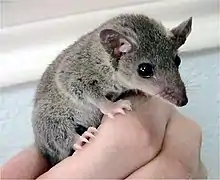Short-tailed opossum
Monodelphis is a genus of marsupials in the family Didelphidae, commonly referred to as short-tailed opossums. They are found throughout South America. As of January 2019, the most recently described species is M. vossi.[1]
| Short-tailed opossums | |
|---|---|
 | |
| Gray short-tailed opossum Monodelphis domestica | |
| Scientific classification | |
| Kingdom: | Animalia |
| Phylum: | Chordata |
| Class: | Mammalia |
| Infraclass: | Marsupialia |
| Order: | Didelphimorphia |
| Family: | Didelphidae |
| Tribe: | Marmosini |
| Genus: | Monodelphis Burnett, 1830 |
| Type species | |
| Monodelphis brachyura Burnett, 1830 | |
| Species | |
|
see text | |
Species
| Cladogram of living Monodelphis[2][3] | ||||||||||||||||||||||||||||||||||||||||||||||||||||||||||||||||||||||||||||||||||||||||||||||||||||||||||||||||||||||||||||||||||||||||||
|
- Sepia short-tailed opossum (Monodelphis adusta)
- Northern three-striped opossum (Monodelphis americana)
- Monodelphis arlindoi
- Northern red-sided opossum (Monodelphis brevicaudata)
- Yellow-sided opossum (Monodelphis dimidiata)
- Gray short-tailed opossum (Monodelphis domestica)
- Emilia's short-tailed opossum (Monodelphis emiliae)
- Gardner's short-tailed opossum (Monodelphis gardneri)
- Amazonian red-sided opossum (Monodelphis glirina)
- Ihering's three-striped opossum (Monodelphis iheringi)
- Pygmy short-tailed opossum (Monodelphis kunsi)
- Marajó short-tailed opossum (Monodelphis maraxina)
- Osgood's short-tailed opossum (Monodelphis osgoodi)
- Hooded red-sided opossum (Monodelphis palliolata)
- Monodelphis pinocchio
- Reig's opossum (Monodelphis reigi)
- Ronald's opossum (Monodelphis ronaldi)
- Chestnut-striped opossum (Monodelphis rubida)
- Monodelphis saci
- Monodelphis sanctaerosae
- Long-nosed short-tailed opossum (Monodelphis scalops)
- Southern red-sided opossum (Monodelphis sorex)
- Southern three-striped opossum (Monodelphis theresa)
- Red three-striped opossum (Monodelphis umbristriata)
- One-striped opossum (Monodelphis unistriata)
- Monodelphis vossi[1]
Speciation is based on fur coloration with additional details coming from differences in the skull and teeth.[4]
Conservation status
M. sorex and M. rubida are considered to be endangered.
Reproductive development
The genus Monodelphis is marsupial; they are born under-developed and then mature further in the mother's pouch. In Monodelphis, the young first come off the teat in 12 days, whereas this occurs at 48 days in the related genus Didelphis. Most of the events in this process occur about 2–4 weeks later in Didelphis than in Monodelphis. This may be related to the shorter longevity of the species of Monodelphis compared to other marsupials who nurse for a longer period.[5] M. dimidiata is unusual in that it is a semelparous species, something rarely seen in mammals, being found predominately in smaller didelphids and dasyurids.
References
- Pavan, Silvia E (11 January 2019). "A revision of the Monodelphis glirina group (Didelphidae: Marmosini), with a description of a new species from Roraima, Brazil". Journal of Mammalogy. 100 (1): 103–117. doi:10.1093/jmammal/gyy165.
- Upham, Nathan S.; Esselstyn, Jacob A.; Jetz, Walter (2019). "Inferring the mammal tree: Species-level sets of phylogenies for questions in ecology, evolution and conservation". PLOS Biol. 17 (12): e3000494. doi:10.1371/journal.pbio.3000494. PMC 6892540. PMID 31800571.
- Amador, Lucila I.; Giannini, Norberto P. (1 September 2016). "Phylogeny and evolution of body mass in didelphid marsupials (Marsupialia: Didelphimorphia: Didelphidae)". Organisms Diversity & Evolution. 16 (3): 641–657. doi:10.1007/s13127-015-0259-x. S2CID 17393886.
- Solari, Sergio (2010). "A molecular perspective on the diversification of short-tailed opossums (Monodelphis: Didelphidae)". Mastozoología Neotropical. 17 (2): 317–333.
- Smith, Kathleen K.; van Nievelt, Alexander F. H. (31 January 1997). "Comparative Rates of Development in Monodelphis and Didelphis". Science. 275 (5300): 683–684. doi:10.1126/science.275.5300.683. PMID 9005857. S2CID 34138665.
Further reading
- Castilheiro, Welvis Felipe Fernandes; Santos Filho, Manoel dos (June 2013). "Diet of Monodelphis glirina (Mammalia: Didelphidae) in forest fragments in southern Amazon". Zoologia (Curitiba). 30 (3): 249–254. doi:10.1590/S1984-46702013000300001.
- González, E. M.; Claramunt, S. (1 January 2000). "Behaviors of captive short-tailed Opossums, Monodelphis dimidiata (Wagner, 1847) (Didelphimorphia, Didelphidae)". Mammalia. 64 (3): 271–286. doi:10.1515/mamm.2000.64.3.271. S2CID 84782113.
- Know Your Short-tailed Opossum: Monodelphis
- Integrated Taxonomic Information System
- Gardner, A.L. (2005). "Order Didelphimorphia". In Wilson, D.E.; Reeder, D.M (eds.). Mammal Species of the World: A Taxonomic and Geographic Reference (3rd ed.). Johns Hopkins University Press. pp. 13–16. ISBN 978-0-8018-8221-0. OCLC 62265494.
External links
 Data related to Monodelphis at Wikispecies
Data related to Monodelphis at Wikispecies